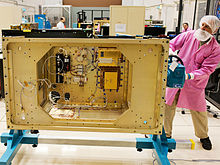Space Communications and Navigation Program
This article may rely excessively on sources too closely associated with the subject, potentially preventing the article from being verifiable and neutral. (August 2023) |

The Space Communications and Navigation (SCaN) program places the three prime NASA space communications networks, Space Network (SN), Near Earth Network (NEN) (previously known as the Ground Network or GN), and the Deep Space Network (DSN), under one Management and Systems Engineering umbrella. It was established in 2006. It was previously known as the Space Communications & Data Systems (SCDS) Program.
History[edit]
Before NASA's administrator Michael D. Griffin created SCaN to direct an integrated networks program, different organizations at NASA Headquarters have managed the Agency's space communications capabilities and functions under separate Programs using a variety of administrative approaches.[2]
The SCaN Office was established by direction of Griffin in a Memorandum entitled "Establishment of a Space Communications and Navigation Office," dated July 19, 2006.[3] SCaN operates as a central organization within the Human Exploration and Operations Mission Directorate (HEOMD):
The Office's responsibilities encompass the management of existing space networks including the Tracking and Data Relay Satellite system, the Deep Space Network, the Ground Network, the NASA Integrated Services Network; implementing any improvements and upgrades to those systems and networks; and developing any future NASA communications and navigation architectures.
The Ground Network (GN) has since been renamed the Near Earth Network.
Services[edit]
SCaN is viewed as a service provider supporting interfaces and performing a standard set of functions, including:[4]
- Forward data transfer (uplink to spacecraft)
- Return data transfer (downlink from spacecraft to ground)
- Dissimilar voice communications
- Emergency communications
- Post-landing communications
- Radiometric measurement
- Time correlation
- Service monitoring
- Ephemeris exchange
- Operational coordination
- Service scheduling.
Communications schemes[edit]
Communications with spaceborne platforms is performed by RF, with a selection of spectra, modulation, and encoding methods, enumerated below.
Spectra[edit]
The Space Network communicates with spacecraft using S-band, Ku-band,[5] and Ka-band with planned laser/optical communications.
The Deep Space Network communicates with spacecraft using S-band, X-band, and Ka-band.
Modulation[edit]
SN uses phase-shift keying and phase modulation of the carrier signal.[6]
Encoding[edit]
The Space Network (used for near-Earth communications) supports the following encoding schemes:[7]
- BPSK
- QPSK/SQPSK
- 8PSK
- Rate 1/2 convolutional coding
- SQPN
- PRN coding - used to reduce power spectral density for low bit rate signals, and for time transfer.
The Reed–Solomon method is used as the initial error-correcting block code prior to the selected secondary encoding scheme.
See also[edit]
References[edit]
- ^ SCaN Testbed homepage at NASA Glenn Research Center
- ^ NASA. Space Communications and Navigation (SCaN) Program Plan. National Aeronautics and Space Administration.
- ^ NASA (January 30, 2009). SCaN Systems Engineering Management Plan (SEMP). NASA Space Communication and Navigation Program Office. SCaN-SEMP.
- ^ NASA (June 28, 2008). Constellation Design Reference Missions And Operational Concepts (ConOps), Annex 1: Constellation Communications and Tracking Concept of Operations (Baseline ed.). National Aeronautics and Space Administration. CxP 70007, ConOps.
- ^ NASA, Exploration and Space Communications Projects Division; Goddard Space Flight Center (August 2007). Space Network User's Guide (SNUG), 2.3, Elements of the SN (Rev 9 ed.). National Aeronautics and Space Administration. 450-SNUG.
- ^ NASA, Exploration and Space Communications Projects Division; Goddard Space Flight Center (August 2007). Space Network User's Guide (SNUG), 6.2 SSA Forward Services, and 6.2.3 Phase Modulation (PM) Signal Parameters (Rev 9 ed.). National Aeronautics and Space Administration. 450-SNUG.
- ^ NASA, Exploration and Space Communications Projects Division; Goddard Space Flight Center (August 2007). Space Network User's Guide (SNUGx) (Rev 9 ed.). National Aeronautics and Space Administration. 450-SNUG.
External links[edit]
